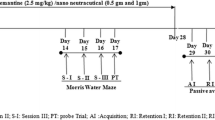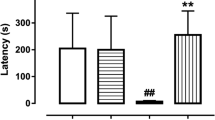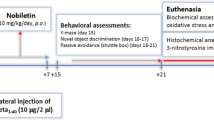Abstract
Oxidative stress and neuroinflammatory changes appear to be the early events involved in AD’s development and progression. The present study was designed to assess the effect of soybean isoflavone extract (SIFE) against colchicine-induced cognitive dysfunction and oxidative stress in male rats.
Fifty adult male Wistar albino rats were divided into five groups: control, ACSF-treated group, soybean isoflavones (SIF)-treated group, colchicine (COL)-treated group, and SIF + COL-treated group. We found that an intracerebroventricular (icv) injection of a single dose of colchicine (7.5 μg/rat bilaterally) resulted in learning deficits in rats subjected to the Morris water maze task associated with marked oxidative damage and decreased acetyl cholinesterase (AChE) activity. In addition, COL caused significant increase in amyloid beta peptide 1-42 (β, amyloid 1-42) interleukin-1β (IL-1β), tumor necrosis factor-α (TNFα), cyclooxygenase-2 (COX-2) and TNF-α genes expression in the brain, and glial fibrillary acidic protein (GFAP) in cortical astrocytes in the brain cortex.
Treatment with SIFE (80 mg/kg b.wt) daily for 14 days followed by a single dose of COL significantly reduced the elevated oxidative stress parameters and restored the reduced antioxidant activities. Besides, the administration of SIFE reversed the overproduction of β, amyloid 1-42, pro-inflammatory cytokines, and GFAP in the brain. The obtained results were confirmed by histological observations that clearly indicate a neuroprotective effect of SIF against AD.



Similar content being viewed by others
References
Aras AB, Guven M, Akman T, Alacam H, Kalkan Y, Silan C, Cosar M (2015) Genistein exerts neuroprotective effect on focal cerebral ischemia injury in rats. Inflammation 38:1311–1321
Baba NA, Raina R, Verma PK, Sultana M, Prawez S, Nisar NA (2013) Toxic effects of fluoride and chlorpyrifos on antioxidant parameters in rats: protective effects of vitamins C and E. Fluoride 46:73–79
Bagchi A (2016) Protective effect of epigallocatechin-3-gallate (EGCG) the major tea polyphenolic, against intracerebroventricularly colchicine induced oxidative damage production in brain and cognitive dysfunction in mice. Alzheimer’s Dis Parkinsonism 6:2161–0460
Bagheri M, Rezakhani A, Nyström S, Turkina MV, Roghani M, Hammarström P, Mohseni S (2013) Amyloid beta1-40-induced astrogliosis and the effect of genistein treatment in rat: a three-dimensional confocal morphometric and proteomic study. PLoS One 8:1–14
Bhatt PC, Pathak S, Kumar V, Panda BP (2017) Attenuation of neurobehavioral and neurochemical abnormalities in animal model of cognitive deficits of Alzheimer‘s disease by fermented soybean nanonutraceutical. Inflammopharmacology 26(3):1–14
Bondan EF, Martins MF, Viani FC (2013) Decreased astrocytic GFAP expression in streptozotocin-induced diabetes after gliotoxic lesion in the rat brainstem. Arq Bras Endocrinol Metabol 57(6):431–436
Brigelius-Flohé R, Maiorino M (2013) Glutathione peroxidases. Biochim Biophys Acta Gen Subj 1830:3289–3303
Cha YS, Park Y, Lee M, Chae SW, Park K, Kim Y, Lee HS (2014) Doenjang, a Korean fermented soy food, exerts antiobesity and antioxidative activities in overweight subjects with the PPAR-γ2 C1431T polymorphism: 12-week, double-blind randomized clinical trial. Med Food 17:119–127
Chiu SC, Yang NS, (2007) Inhibition of tumor necrosis factor-alpha through selective blockade of Pre-mRNA splicing by shikonin. Mol Pharmacol.;71(6):1640–5
Chiu DT, Stults FH, Tappel AL (1976) Purification and properties of rat lung soluble glutathione peroxidase. Biochim Biophys Acta Enzymol 445:558–566
Devi KP, Shanmuganathan B, Manayi A, Nabavi SF, Nabavi SM (2017) Molecular and therapeutic targets of genistein in Alzheimer’s disease. Mol Neurobiol 54:7028–7041
Ding BJ, Ma WW, He LL, Zhou X, Yuan LH, Yu HL, Feng JF, Xiao R (2011) Soybean isoflavone alleviates β-amyloid 1-42 induced inflammatory response to improve learning and memory ability by down regulation of Toll-like receptor 4 expression and nuclear factor-κB activity in rats. Int J Dev Neurosci 29:537–542
Ding J, Yu HL, Ma WW, Xi YD, Zhao X, Yuan LH, Feng JF, Xiao R (2013) Soy isoflavone attenuates brain mitochondrial oxidative stress induced by beta-amyloid peptides 1–42 injection in lateral cerebral ventricle. Neurosci Res 91:562–567
Drury RA, Wallington EA (1980) Carleton's Histological Technique (5thed.) Oxford University Press. Oxford New York Toronto 188-189(237240):290–291
Ellman GL, Courtney KD, Anders VJ, Featherstone RM (1961) A new rapid colorimetric determination of acetylcholinesterase activity. Biochem Pharmacol 7:88–95
Ferguson-Smith AC, Chen YF, Newman MS, May LT, Sehgal PB, Ruddle FH (1988) Regional localization of the interferon-β2B-cell stimulatory factor 2/hepatocyte stimulating factor gene to human chromosome 7p15-p21. Genomics 2:203–208
Ganesh P, Karthikeyan R, Muthukumaraswamy A, Anand J (2017) A potential role of periodontal inflammation in Alzheimer’s disease: a review. Oral Health Prev Dent 15:7–12
Habig WH, Pabst MJ, Jakoby WB (1974) Glutathione S-transferases.The first enzymatic step in mercapturic acid formation. Biol Chem 249:7130–7139
Hedayati M, Yazdanparast R, Azizi F (2001) Determination of human tumor necrosis factor α by a highly sensitive enzyme immunoassay. Biochem Biophys Res Commun 289:295–298
Jollow DJ, Mitchell JR, Zampaglione NA, Gillette JR (1974) Bromobenzene-induced liver necrosis.Protective role of glutathione and evidence for 3, 4-bromobenzene oxide as the hepatotoxic metabolite. Pharmacology 11:151–169
Khurana S, Jain S, Mediratta PK, Banerjee BD, Sharma KK (2012) Protective role of curcumin on colchicine-induced cognitive dysfunction and oxidative stress in rats. Hum Exp Toxicol 31:686–697
Kumar A, Seghal N, Naidu PS, Padi SS, Goyal R (2007) Colchicines induced neurotoxicity as an animal model of sporadic dementia of Alzheimer’s type. Pharmacol Rep 59:274–283
Kumar A, Dogra S, Prakash A (2009) Neuroprotective effects of Centella asiatica against intracerebroventricular colchicine-induced cognitive impairment and oxidative stress. Int J Alzheimers Dis 2009:1–8. https://doi.org/10.4061/2009/972178
Kwon Y (2014) Effect of soy isoflavones on the growth of human breast tumors: findings from preclinical studies. Food Sci Nutr 2:613–622
Legos JJ, Tuma RF, Barone FC (2002) Pharmacological interventions for stroke: failures and future. Expert Opin Investig Drugs 11(5):603–614
Letenneur L, Proust-Lima C, Le Gouge A, Dartigues JF, Barberger-Gateau P (2007) Flavonoid intake and cogni tive decline over a 10-year period. Am J Epidemiol 15(165(12)):1364–1371
Lim KL, Tay A, Nadarajah VD, Mitra NK (2011) The effect of consequent exposure of stress and dermal application of low doses of chlorpyrifos on the expression of glial fibrillary acidic protein in the hippocampus of adult mice. Occup Med Toxicol 6:1–9
Livak KJ, Schmittgen TD (2001) Analysis of relative gene expression data using real-time quantitative PCR and the 2− ΔΔCT method. Methods 25:402–408
Lowry OH, Rosebrough NJ, Farr AL, Randall RJ (1951) Protein measurement with the Folin phenol reagent. Biol Chem 193:265275
Maiti P, Paladugu L, Dunbar GL (2018) Solid lipid curcumin particles provide greater anti-amyloid, anti-inflammatory and neuroprotective effects than curcumin in the 5xFAD mouse model of Alzheimer’s disease. BMC Neurosci 19(1):7. https://doi.org/10.1186/s12868-018-0406-3
Malkiewicz K, Koteras M, Folkesson R, Brzezinski J, Winblad B, Szutowski M, Benedikz E (2006) Cypermethrin alters glial fibrillary acidic protein levels in the rat brain. Environ Toxicol Pharmacol 21:51–55
Mansour SA, Moss AT (2010) Oxidative damage, biochemical and histopathological alterations in rats exposed to chlorpyrifos and the antioxidant role of zinc. Pestic Biochem Physiol 96:14–23
Misra HP, Fridovich I (1972) The role of superoxide anion in the autoxidation of epinephrine and a simple assay for superoxide dismutase. Biol Chem 247:3170–3175
Mohamed AR, Soliman GY, Ismail CA, Mannaa HF (2015) Neuroprotective role of vitamin D3 in colchicine-induced Alzheimer’s disease in rats. Alexandria J Med 51:127–136
Montogomery HA, Dymock JF (1961) The determination of nitrite in water: colorimetric method of nitric oxide assay. Analyst 86:414–416
Nimse SB, Pal D (2015) Free radicals, natural antioxidants, and their reaction mechanisms. RSC Adv 5:27986–28006
Ohkawa H, Ohishi N, Yagi K (1979) Assay for lipid peroxidation in animal tissues by thiobarbituric acid reaction. Ann Biochem 95:351–358
Park YJ, Ko JW, Jeon S, Kwon YH (2016) Protective effect of genistein against neuronal degeneration in ApoE−/− mice fed a high-fat diet. Nutrients 8:1–11
Qian Y, Guan T, Huang M, Cao L, Li Y, Cheng H, Jin H, Yu D (2012) Neuroprotection by the soy isoflavone, genistein, via inhibition of mitochondria-dependent apoptosis pathways and reactive oxygen inducedNF-κB activation in a cerebral ischemia mouse model. Neurochem Int 60:759–767
Roy C, Das SK (2013) Role of Moringa oleifera on brain electrical activity in colchicine induced experimental rat model of Alzheimer’s disease: possible involvement of antioxidants. Int J Curr Pharm Res 5:40–45
Shabab T, Khanabdali R, Moghadamtousi SZ, Kadir HA, Mohan G (2017) Neuroinflammation pathways: a general review. Int J Neurosci 127:624–633
Sharma VK (2010) Experimental models for alzheimer’s disease: a mechanistic view. Int J Pharm Sci Res 1:13–22
Sil S, Goswami AR, Dutta G, Ghosh T (2014) Effects of naproxen on immune responses in a colchicine-induced rat model of Alzheimer’s disease. Neuroimmunomodulation 21:304–321
Sil S, Ghosh R, Sanyal M, Guha D, Ghosh T (2016) A comparison of neurodegeneration linked with neuroinflammation in different brain areas of rats after intracerebroventricular colchicine injection. Immunotoxicology 13:181–190
Sovrea AS, Bosca AB, Georgiu C, Constantin AM, Ben AM, Gheban D (2014) The diagnostic value of immunohistochemistry and silver impregnation techniques for characterization of normal, reactive and tumoral astrocytes. Romanian J Morphol Embryol 55:525–538
Taliaz D, Loya A, Gersner R, Haramati S, Chen A, Zangen A (2011) Resilience to chronic stress is mediated by hippocampal brain-derived neurotrophic factor. J Neurosci 31:4475–4483
Torres LL, Quaglio NB, de Souz GT, Garcia RT, Dati LM, Moreira WL et al (2011) Peripheral oxidative stress biomarkers in mild cognitive impairment and Alzheimer’s disease. J Alzheimers Dis 26(1):59–68
Unno K, Konishi T, Nakagawa A, Narita Y, Takabayashi F, Okamura H, Hara A, Yamamoto H, Iguchi K, Hoshino M, Yasui K (2015) Cognitive dysfunction and amyloid β accumulation are ameliorated by the ingestion of green soybean extract in aged mice. J Funct Foods 14:345–353
Varinska L, Gal P, Mojzisova G, Mirossay L, Mojzis J (2015) Soy and breast cancer: focus on angiogenesis. Int J Mol Sci 16:11728–11749
Velho S, Marques-Vidal P, Baptista F, Camilo ME (2008) Dietary intake adequacy and cognitive function in free-living active elderly: a cross-sectional and short-term prospective study. Clin Nutr 27(1):77–86
Wang B, Du Y (2013) Cadmium and its neurotoxic effects. Oxidative Med Cell Longev 2013:1–12. https://doi.org/10.1155/2013/898034
Wang WY, Tan MS, Yu JT, Tan L (2015) Role of pro-inflammatory cytokines released from microglia in Alzheimer’s disease. Ann Transl Med 3:136–145
Wu YC, Zheng D, Sun JJ, Zou ZK, Ma ZL (2015) Meta-analysis of studies on breast cancer risk and diet in Chinese women. Int J Clin Exp Med 8:73–85
Yoon G, Park S (2014) Antioxidant action of soy isoflavones on oxidative stress and antioxidant enzyme activities in exercised rats. Nutr Res Pract 8:618–624
Yu J, Bi X, Yu B, Chen D (2016) Isoflavones: anti-inflammatory benefit and possible caveats. Nutrients 8:361–366
Zhai X, Lin M, Zhang F, Hu Y, Xu X, Li Y, Liu K, Ma X, Tian X, Yao J (2013) Dietary flavonoid genistein induces Nrf2 and phase II detoxification gene expression via ERKs and PKC pathways and protects against oxidative stress in Caco-2 cells. Mol Nutr Food Res 57:249–259
Zhang L, Fang Y, Lian Y, Chen Y, Wu T, Zheng Y, Zong H, Sun L, Zhang R, Wang Z, Xu Y (2015) Brain-derived neurotrophic factor ameliorates learning deficits in a rat model of Alzheimer’s disease induced by Aβ1-42. PLoS One 10:1–14
Zhao Z, Ho L, Wang J, Qin W, Festa ED, Mobbs C, Hof P, Rocher A, Masur S, Haroutunian V, Pasinetti GM (2005) Connective tissue growth factor (CTGF) expression in the brain is a downstream effector of insulin resistance-associated promotion of Alzheimer’s disease β-amyloid neuropathology. FASEB J 19:2081–2082
Zheng Z, Sabirzhanov B, Keifer J (2010) Oligomeric amyloid-β inhibits the proteolytic conversion of brain-derived neurotrophic factor (BDNF), AMPA receptor trafficking, and classical conditioning. J Biol Chem 285:34708–34717
Author information
Authors and Affiliations
Corresponding author
Ethics declarations
Conflict of interest
The authors declare that they have no conflict of interest.
Additional information
Responsible editor: Philippe Garrigues
Publisher’s note
Springer Nature remains neutral with regard to jurisdictional claims in published maps and institutional affiliations.
Rights and permissions
About this article
Cite this article
Essawy, A.E., Abdou, H.M., Ibrahim, H.M. et al. Soybean isoflavone ameliorates cognitive impairment, neuroinflammation, and amyloid β accumulation in a rat model of Alzheimer’s disease. Environ Sci Pollut Res 26, 26060–26070 (2019). https://doi.org/10.1007/s11356-019-05862-z
Received:
Accepted:
Published:
Issue Date:
DOI: https://doi.org/10.1007/s11356-019-05862-z




